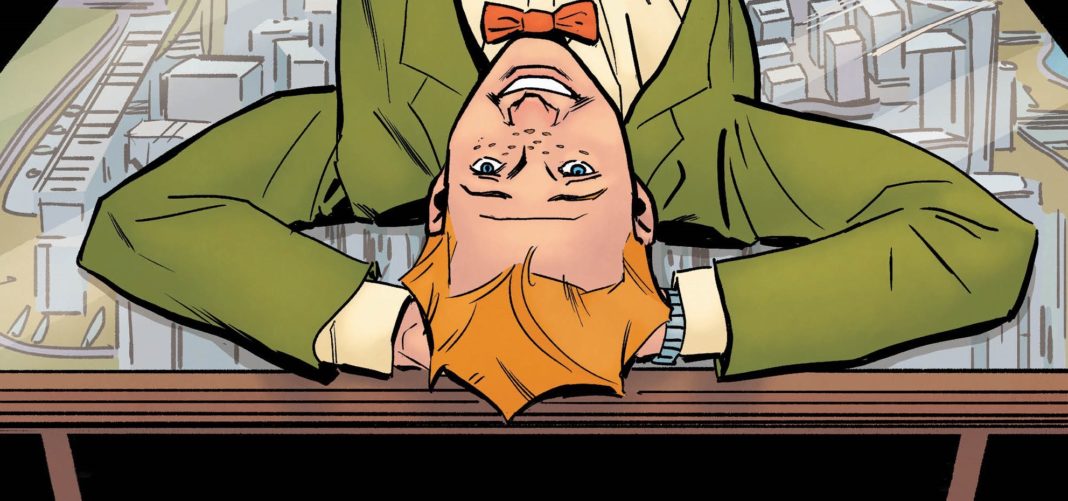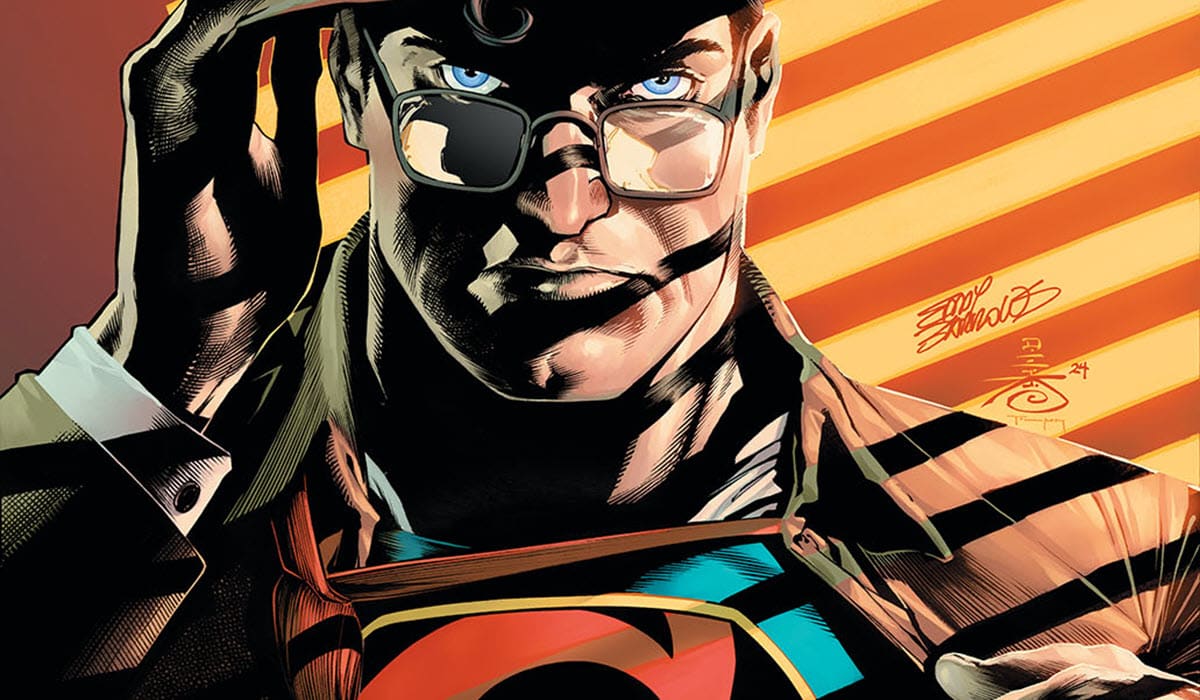DC’s Rose City Comic Con panel “Lois and Jimmy — Friends of Superman” had the audience absolutely rolling as the creative teams behind the current iterations of Superman’s iconic supporting characters dove into the each characters’ respective (and absurd) histories leading to how we see them now. Moderated by professor and superhero scholar Ben Saunders, the panelists included Lois Lane writer Greg Rucka, as well as the ragtag team behind Superman’s Pal Jimmy Olsen, writer Matt Fraction and artist Steve Lieber.
Saunders really kicked off the panel by introducing the idea that, when writing what are traditionally supporting characters of Superman, he felt that it must be difficult to get over the main challenge of detaching the characters from Superman’s orbit. This lead to him asking the panelists how they best go about dealing with “the Superman factor of it all.”
Before directing answering the question, Rucka went into great detail about leaning into moments outside of Superman. He gave an example of a future issue where Renee Montoya (a.k.a. The Question) uses a Letterkenny quote when dealing with a foe — referring to him as “big shoots” as he plummets from a building. Rucka gave away more by saying that Superman flies up behind her without her notice and inquires about her using “big shoots.” There was a great laugh from the audience when Rucka explained that Renee responded by telling Superman that it’s best if he hasn’t really heard about Letterkenny.
“You always turn into the skit,” said Rucka. “You go with it and you say ‘this is the thing and we gotta use it.’ If you ignore it, you render the book irrelevant. If you’re going to tell a story that is in any way true, you have to embrace all of the truth in it. Lois and Jimmy both have very different and unique relationships with Superman.”
Saunders projected the first appearance of Lois Lane onto the screen followed by another, older panel in which Lois is clearly under the impression that she can ensnare Clark Kent with her feminine whiles. This kicked off a great discussion of Lois Lane’s origins in Superman comics and the anti-feminist message that tended to come with her.
“This was never the Lois I really thought of when making Lois Lane. I thought of the Lois from the Superman movies. I saw that in the theater and…while there’s still a vaguely anti-feminist joking tone, it’s more diminished. There’s no real making fun of Lois. Ever,” Rucka said.
Up on the screen, Saunders reeled through several old pages of comics, including Superman’s Girlfriend Lois Lane. Some of these are ridiculous and — in retrospect — very funny. One highlight is an issue of Superman’s Girlfriend Lois Lane where Lois has Superman tied down…as she whips a tied up doll of Superman.
“The person who was in charge of this was in the middle of going to therapy and was working through things in a very Freudian manner,” laughed Lieber.
Fraction then launched into a side-splitting story about how the cover reminded him of what they refer to in their home when someone explains a dream that everyone understands except the dreamer, and that’s exactly what the cover was. The audience absolutely ate it up and spent a solid while recovering from laughter.
From there, Saunders shifted over to discussing Jimmy Olsen and projected pictures of old Jimmy Olsen comics up onto the screen. He asked what the team is up to with Jimmy Olsen now and made a remark about how every old issue of Superman’s Pal Jimmy Olsen somehow involves people wanting to do strange things to Jimmy’s body.
“At one point they turn him into a melty faced dog boy!” interjected Fraction. “It’s gonna sound like I’m being profane but they make his face melty and there’s a vaginal transformation about it in that issue. It’s horrifying.”
Saunders brought up an old cover of Jimmy Olsen and asked, “What about this? You kind of riffed on this in issue one.”
“I just wanted to see if Steve would do it, honestly,” replied Fraction. “I like the idea of Jimmy being a person who’s like ‘This is a crazy Tuesday!’ I like that he’s the guy who would just say stuff like ‘You remember when I was a turtle and killed those people?’ like it’s not a big deal.”
Lieber piped in by saying that in one of the pencil sketches, he did actually include the turtle’s junk. “But we’re saving that for the hardcover,” he joked. Fraction seemed more than a little surprised and intrigued.
“One of the great advantages as an artist is that every story [in Jimmy Olsen] is a different genre almost,” continued Lieber. “History, crime, sitcom…whatever. I’m an artist who likes to shift my style. I like to play with tone and I’m constantly getting to be a different guy. It’s a wonderful opportunity. I’m not in the same place month after month. Because comics are a marathon, not a sprint. Getting to shift around with stories like this is a gift.”
Saunders then brought up what is best referred to as “the famous crossdressing Jimmy stories.”
Fraction immediately jumped in to say that the best part about Jimmy dressing en femme during the older comics was that it stopped being something to question at all really quickly. He also brought up an issue where there is a Jimmy Olsen fan club where Jimmy decides to show up inexplicably dressed in drag. When the boys push back and try to play the “No Girls Allowed!” card, Jimmy says he’s just a big a fan as them and challenges them. Every time he wins he makes them do something that — at the time — was considered effeminate.
“There’s not even an ‘AHA! I was Jimmy all along!’ moment!” said Fraction. “The story just leaves everything as-is with Jimmy still in drag and all of the boys suitably shamed and feeling inadequate in their masculinity.”
Saunders then shifted the panel back to Lois Lane and asked Rucka about any editorial pushbacks he’s received about the way he has made Lois a part of the journalistic discourse of 2019. The example best used is issue number one, where Lois is in a hotel room and the voiceover from the news in the background is about the current political status of what we know from reality.
“I’m at an age and state in my career where I told them what I was going to do at the start. She’s going to be an investigative reporter. And if she’s around now you cannot write her not talking about this,” said Rucka. “She’s a reporter. She investigates and then she writes. You’re never gonna read what she writes. You’re gonna see the effects of it. Her super power is her pencil and paper.”
The conversation then moved to talking about Clark not understanding why Lois is treated differently for being a woman in her field; when she explains, he just gets mad.
“It just doesn’t occur to Clark that someone would treat her differently,” remarked Fraction.
“I don’t think he’s oblivious,” countered Rucka. “He’s a husband. He’s upset and hurt because of what his wife is being subjected to. It’s that “I can’t fix it” problem. Her sanguine response is that it is what it is.”
The group continued to talk about the state of journalism in the current atmosphere and how it applies to how Rucka tackles Lois in the current day under the current political climate. It was at this point that a large number of people began to leave the room, not going unnoticed by the panelists.
As the panel began to wrap up, the panelists gave their last thoughts on why these once-niche and very quirky books are finding their home in the contemporary field of comics.
“It’s not just about nostalgia,” said Saunders. “What is it about making this old material work today that makes these books contemporary?”
“For me it comes from knowing what Steve can do. He’s gifted,” said Fraction. “We go to a lot of length to make this silly but it’s actually very ornately constructed and planned out. Regardless, Superman has always been social fiction in his origins. You can say the same for Lois and Jimmy, too.”
Lois Lane issues #1-3 and Superman’s Pal Jimmy Olsen issues #1-2 are currently available at any comics retailer.








“The person who was in charge of this was in the middle of going to therapy and was working through things in a very Freudian manner,” laughed Lieber.
No joke. Editor Mort Weisinger really was in therapy at the time.
Comments are closed.